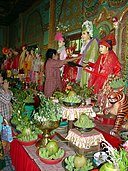Mya Nan Nwe
 From Wikipedia the free encyclopedia
From Wikipedia the free encyclopedia
Mya Nan Nwe | |
|---|---|
 Mya Nan Nwe Statue | |
| Born | 22 December 1897 |
| Died | February 1956 (aged 49) |
| Nationality | Burmese |
| Other names | Ma Nan |
| Known for | As the dragon guarding the pagoda |
| Parent(s) | Chan Thar (father) Nann Kham (mother) |
Mya Nan Nwe (Burmese: မြနန်းနွယ်; Thai: เมียะนานหน่วย, lit. 'angel of whispers'), also known as Thaiknanshin (သိုက်နန်းရှင်, lit. "keeper of the treasure trove") or more popularly known among Thai people as Amadaw Mya (Thai: อะมาดอว์เมียะ)[1] is a prominent Burmese nat. She was known to be a dragon guarding the Botahtaung Pagoda.[2][3]
Lifetime[edit]

Mya Nan Nwe was born on 22 December 1897 in Mogok, British Burma. She is the descendant of Saopha, and daughter of Chan Thar and Nann Kham. At 15-years-old, she was educated in India and graduated with B.A. in 1926.[citation needed] From Mogok, dignitaries wanted to marry her, but she refused. She did not eat meat from an early age. In 1942, in her dream, an old man in white robes told her that she should move to Yangon as a missionary. So, she moved to Botataung Pagoda Road, Yangon, and worshiped Botataung Pagoda daily. She had been called Princess of Green as she wore green clothes.[4] She contributed to religious works, including the rebuilding of the Botahtaung Pagoda after its destruction during World War II.[2]
Some believe that she was a daughter of a nāga.[1]
Deification[edit]

Mya Nan Nwe died in Mogok in February 1956, due to complications related to long-term asthma.[2] After her death in 1957, Mya Nan Nwe became a revered figure in her own right. In 1990, her shrine was erected inside the Botahtaung Pagoda, and from that point on she was worshipped as Mya Nan Nwe Dewi (Goddess), a nat with the power to grant the wishes of those who appealed to her for help. She was known to be a nāga who guards the pagoda. Hundreds of people come to this place to donate offertories and also to ask for blessing of the sister.[5][2]
Shrine[edit]
The shrine attracts 700 worshippers per day, and between 1,000 and 3,000 worshippers on weekends, including many Thai devotees.[6][2] She gained popularity in Thailand through a Thai television program featured her biography.[2]
The oppressive dictator Than Shwe had ordered her statue to be handcuffed every night during his rule. It is said that she appeared in the dictator's dream asking him to stop oppressing the citizens of Myanmar. The dictator was notably highly superstitious and saw this as a bad omen, hence ordering her statue in the shrine to be handcuffed at night.[1][7]
See also[edit]
References[edit]
- ^ a b c อุ่ยเต็กเค่ง, คมกฤช (2021-10-08). "คมกฤช อุ่ยเต็กเค่ง : เทวดาจะอยู่ข้างไหน?" [Which [Political] Side do the Angels Choose?] (in Thai). Matichon. Retrieved 2021-11-20.
- ^ a b c d e f May Sitt Paing (22 July 2014). "Thais Find a Spiritual Home in Yangon". The Irrawaddy. Retrieved 19 July 2015.
- ^ Zon Pann Pwint (29 July 2015). "Living on borrowed time". The Myanmar Times. Retrieved 18 August 2018.
- ^ "ဝါတွင်းတိုင်းသီလရှင်ဝတ်ပါတယ် ဆိုသောအစ်မတော်မြနန်းနွယ်သမိုင်းကြောင်း". dailyhotnews (in Burmese). Retrieved 13 August 2018.
- ^ Ahmagyi Mya Nan Nwe, a devotee to the Botahtaung Pagoda.
- ^ "အစ်မတော် မြနန်းနွယ် တကယ်ပဲ ဆုတောင်းပြည့်စေလား" (in Burmese). Kamayut Media. 16 July 2015. Retrieved 19 July 2015.
- ^ Wai, Kyi (2009-11-19). "Mystery of the Handcuffed Statues". The Irrawaddy. Retrieved 2021-11-20.
